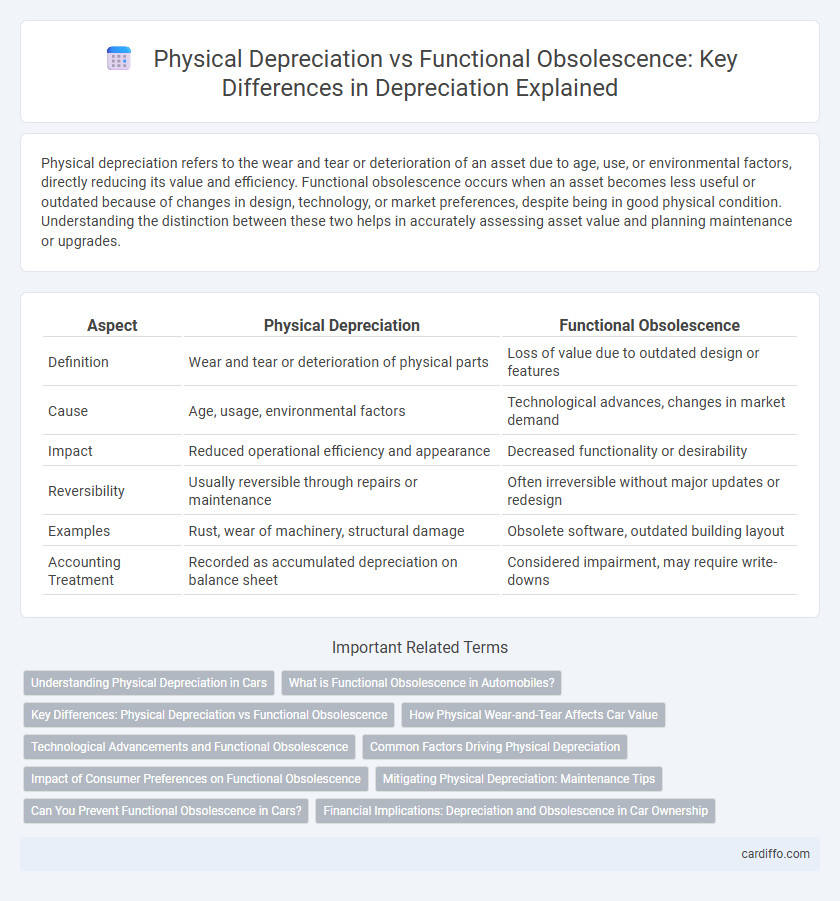Physical depreciation refers to the wear and tear or deterioration of an asset due to age, use, or environmental factors, directly reducing its value and efficiency. Functional obsolescence occurs when an asset becomes less useful or outdated because of changes in design, technology, or market preferences, despite being in good physical condition. Understanding the distinction between these two helps in accurately assessing asset value and planning maintenance or upgrades.
Table of Comparison
| Aspect | Physical Depreciation | Functional Obsolescence |
|---|---|---|
| Definition | Wear and tear or deterioration of physical parts | Loss of value due to outdated design or features |
| Cause | Age, usage, environmental factors | Technological advances, changes in market demand |
| Impact | Reduced operational efficiency and appearance | Decreased functionality or desirability |
| Reversibility | Usually reversible through repairs or maintenance | Often irreversible without major updates or redesign |
| Examples | Rust, wear of machinery, structural damage | Obsolete software, outdated building layout |
| Accounting Treatment | Recorded as accumulated depreciation on balance sheet | Considered impairment, may require write-downs |
Understanding Physical Depreciation in Cars
Physical depreciation in cars refers to the gradual loss of a vehicle's value due to wear and tear from regular use, exposure to elements, and aging components. Common indicators include rust formation, paint fading, tire wear, and engine deterioration, all of which directly reduce the car's operational efficiency and aesthetic appeal. Unlike functional obsolescence, which stems from outdated technology or design, physical depreciation is measurable through tangible damage and maintenance records that impact resale value.
What is Functional Obsolescence in Automobiles?
Functional obsolescence in automobiles refers to the loss of value due to outdated design, technology, or features that no longer meet current standards or consumer preferences. This type of depreciation occurs despite the vehicle's physical condition remaining intact, often driven by advancements such as improved safety systems, fuel efficiency, or infotainment options in newer models. Understanding functional obsolescence helps in accurately assessing a car's market value beyond mere wear and tear.
Key Differences: Physical Depreciation vs Functional Obsolescence
Physical depreciation refers to the tangible wear and tear or deterioration of an asset's physical components due to age, usage, or environmental factors, directly affecting its operational efficiency. Functional obsolescence occurs when an asset loses value because of outdated design, technology, or features that no longer meet current standards, even if the physical condition remains intact. The key difference lies in physical depreciation impacting the asset's material state, while functional obsolescence diminishes usefulness based on functionality and relevance.
How Physical Wear-and-Tear Affects Car Value
Physical wear-and-tear directly reduces a car's market value by deteriorating essential components such as the engine, tires, and bodywork, leading to costly repairs and diminished performance. Unlike functional obsolescence, which stems from outdated technology or design, physical depreciation results from everyday usage and environmental factors that accumulate damage over time. This tangible decline in condition lowers resale prices and increases maintenance expenses, making physical depreciation a critical consideration in vehicle valuation.
Technological Advancements and Functional Obsolescence
Functional obsolescence occurs when technological advancements render a property's features outdated, reducing its value despite good physical condition. This type of depreciation reflects changes in market demands or innovations that make existing structures less efficient or desirable. Physical depreciation, in contrast, results from wear and tear, whereas functional obsolescence is driven by shifts in technology and consumer expectations impacting asset utility.
Common Factors Driving Physical Depreciation
Common factors driving physical depreciation include wear and tear from regular use, exposure to environmental elements like moisture, temperature fluctuations, and UV radiation, and damage caused by accidents or natural disasters. These factors gradually reduce an asset's operational efficiency and structural integrity. Effective maintenance and timely repairs can mitigate the rate of physical depreciation over time.
Impact of Consumer Preferences on Functional Obsolescence
Functional obsolescence occurs when changes in consumer preferences reduce the desirability or usefulness of an asset despite its physical condition. Factors such as shifts in technology, design trends, or feature demands can accelerate depreciation beyond physical wear and tear. Real estate and consumer electronics commonly face functional obsolescence as market preferences evolve rapidly.
Mitigating Physical Depreciation: Maintenance Tips
Regular maintenance such as timely repairs, cleaning, and protective coatings significantly slows physical depreciation by preserving a property's structural integrity and appearance. Implementing routine inspections helps identify wear and tear early, preventing minor issues from escalating into costly damages. Using durable materials and upgrading key components also enhances longevity, reducing the overall rate of physical depreciation.
Can You Prevent Functional Obsolescence in Cars?
Functional obsolescence in cars occurs when a vehicle's features or technology become outdated compared to newer models, leading to a decline in value despite its physical condition. While physical depreciation can be minimized through regular maintenance and repairs, preventing functional obsolescence is challenging due to rapid advancements in automotive technology and changing consumer preferences. Upgrading infotainment systems or safety features can mitigate some effects, but complete prevention of functional obsolescence is generally not feasible.
Financial Implications: Depreciation and Obsolescence in Car Ownership
Physical depreciation in car ownership reflects the gradual wear and tear reducing the vehicle's market value, directly impacting resale prices and insurance premiums. Functional obsolescence occurs when newer car models or technologies render existing vehicles less desirable, affecting long-term depreciation rates and influencing decisions on trade-ins or upgrades. Both factors contribute to the total depreciation expense accounted for in financial planning, affecting tax deductions and overall cost of ownership.
Physical Depreciation vs Functional Obsolescence Infographic

 cardiffo.com
cardiffo.com